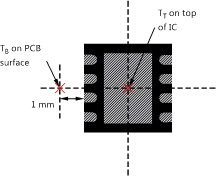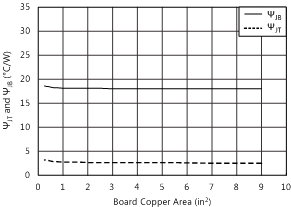JAJSGW8B October 2014 – February 2019 TPS735-Q1
PRODUCTION DATA.
- 1 特長
- 2 アプリケーション
- 3 概要
- 4 改訂履歴
- 5 Pin Configuration and Functions
- 6 Specifications
- 7 Detailed Description
- 8 Application and Implementation
- 9 Power Supply Recommendations
- 10Layout
- 11デバイスおよびドキュメントのサポート
- 12メカニカル、パッケージ、および注文情報
パッケージ・オプション
デバイスごとのパッケージ図は、PDF版データシートをご参照ください。
メカニカル・データ(パッケージ|ピン)
- DRB|8
サーマルパッド・メカニカル・データ
発注情報
10.1.5 Estimating Junction Temperature
Using the thermal metrics ΨJT and ΨJB, as shown in the table, the junction temperature can be estimated with the corresponding formulas (given in Equation 5).
Equation 5. 

where
- PD is the power dissipation calculated with Equation 2,
- TT is the temperature at the center-top of the device package, and
- TB is the PCB temperature measured 1 mm away from the device package on the PCB surface (as shown in Figure 23).
 Figure 23. Measuring Points for TT and TB
Figure 23. Measuring Points for TT and TB NOTE
Both TT and TB can be measured on actual application boards using an infrared thermometer.
For more information about measuring TT and TB, see the application note, Using New Thermal Metrics, SBVA025.
According to Figure 24, the thermal metrics (ΨJT and ΨJB) have very little dependency on copper area. Using ΨJT or ΨJB with Equation 5 is a good way to estimate TJ by simply measuring TT or TB on an application board.
 Figure 24. ΨJT and ΨJB vs Board Size
Figure 24. ΨJT and ΨJB vs Board Size